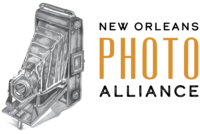In their new exhibit, “Cajun Document 1974” at the Historic New
Orleans Collection, photographers Charles Traub and Douglas Baz
masterfully capture the bell-bottomed glory of mid-Seventies Acadiana
with a powerful group of 30 black and white square-format photographs.
The content of the images is landscapes, portraits, and downright
quirky moments. The style is a deceptively simple black & white
that, while appearing “classic” in many outward pictorial qualities,
never fails to surprise with taut compositions and an exceptional
choice of subjects.
Consider “Boucherie II”; a large morbid pig’s head in sharp focus is
held hand-puppet style by a man who may be either the butcher in
question or simply one enlisted to pose as mime. Or “Mardi Gras
Masker At Rest” where it takes a second look to determine the
carnival mask sitting atop a horse’s rump is actually a face mask
tilted back on top of a reveler’s head who lies back upon his horse.
These images are at once playful, surreal, macabre and ordinary.
Traub and Baz manage to reveal the strangeness of Cajun country by
just showing it to us without contrivance or artifice. The numerous
portraits in the show are all fine examples of this occasionally
surreal vibe. “Bride And Groom” in lesser hands would have been
cropped in close to the newly married couple, instead we see the
liberally “monied” pair (the Cajun tradition of pinning currency to
the white tux and bridal gown) standing under a large expanse of
mildewed plywood soffit outside their reception hall. In “Jockey
With Crop and Tack” a rural black teen in riding helmet stands before
a mixed-race gathering of horse bettors leaving us to ponder the
vagaries of segregation and integration in post-Civil Rights Louisiana.
The choice of subjects in the series is also noteworthy. As one who
has photographed the world of Zydeco music extensively I can only
envy the perfection of “Clifton Chenier” in his prime, shining vocal
mic firmly attached to his piano accordion, gold teeth gleaming.
“Accordion Player” is none other than the master of Cajun funk,
Nathan Abshire (a notoriously difficult-to-photograph musician)
laughing for the camera…in a sombrero! Traub and Baz were there
with film when it mattered and we are all the richer for it.
The prints appear to be slighly warm-tone digital giclees but they
display a luscious range of silvery grays, lovely film grain, and
tonal integrity. “Towboat Model” is a fine example of dreamlike
scale manipulation (a small tugboat model appears massive against
textures of lapping waves and backlit clouds) achieved through
perfect exposure and development.
Traub and Baz forego any singular authorship of these images as none
display either artist’s name. Mr. Traub recalls: “It’s hard to tell
who photographed what. Our styles melded together. It was a shared
undertaking. There was no real plan–just the desire to see,
experience, talk, engage, and photograph.” It’s hard to resist such
sincerity and the work fairly sings with their passion and
engagement. The exhibit will be up at the Williams Research Center,
410 Chartres Street, until February 20th.
Rick Olivier
